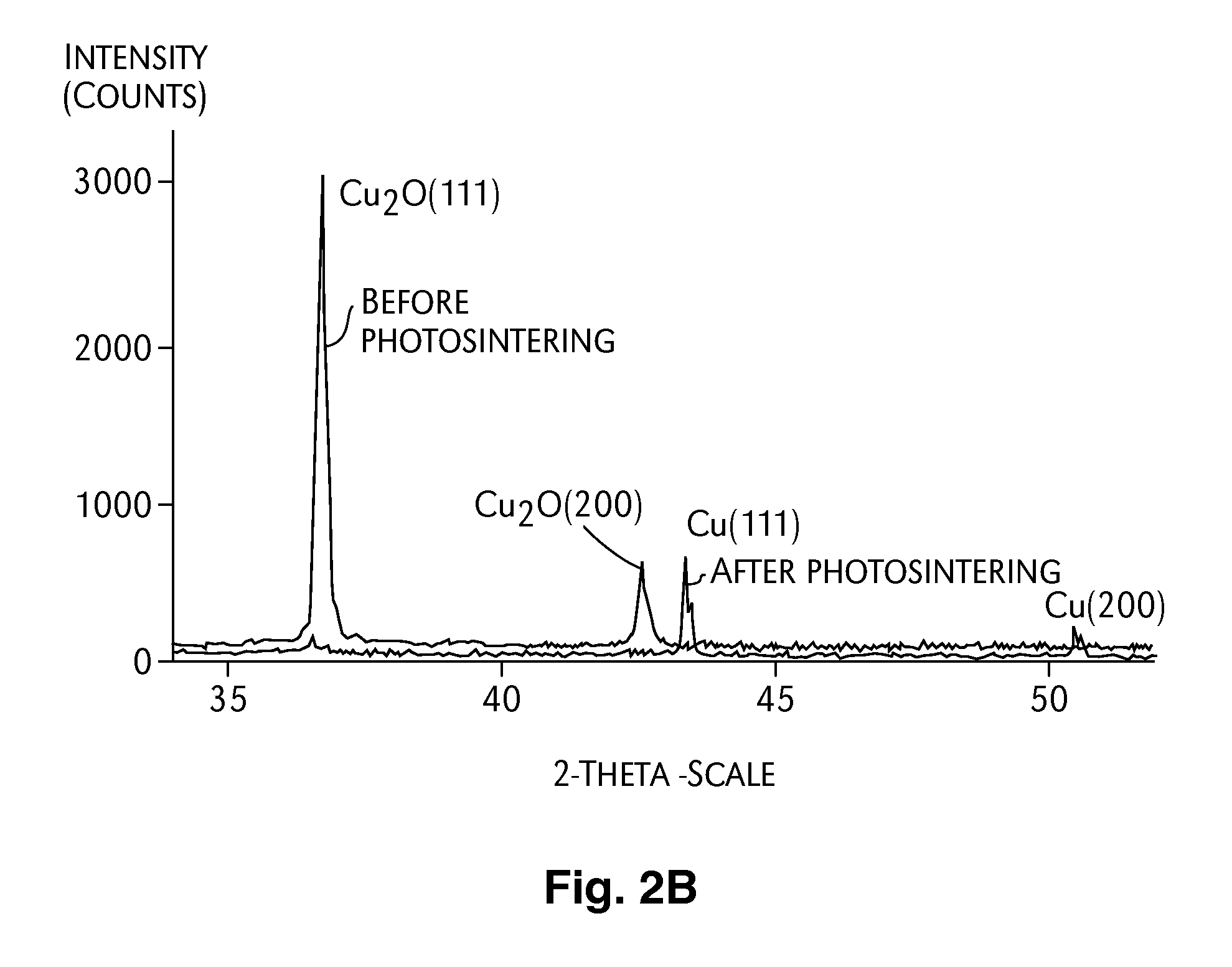Metallic ink
a technology of ink and metal, applied in the field of metal ink, can solve the problems of increasing cost, adding significant cost to the product, and expensive metals
- Summary
- Abstract
- Description
- Claims
- Application Information
AI Technical Summary
Benefits of technology
Problems solved by technology
Method used
Image
Examples
example 1
Non-Ionic Polymeric Dispersants for Copper Inks
[0097]This “excluded” volume represents the space “Occupied” by the flexible alkyl (or ethoxy) chain, and it is space that cannot be occupied by a second copper nanoparticlc. The larger this “excluded” volume the more effective is the dispersant at keeping the copper nanoparticles separated. A second aspect of this “excluded” volume is that large values allow for low concentrations of the compound to be effective in providing a high level of coverage of the nanoparticle, and therefore a high degree of effectiveness as a dispersant.
[0098]Polymers that have been successfully used in the formulation of inks that have been subsequently cured by photonic cured to provide good conductors are Triton X-100, Triton X-15, Triton X-45, Triton QS-15, liner alkyl ether (colar Cap MA259, colar Cap MA1610), quaternized alkyl imidazoline (Cola Solv IES and Cola Solv TES), polyvinylpyrrolidone (PVP), polyvinyl alcohol, polyethylene glycol, and polysilox...
example 2
Ionic Polymeric Dispersants for Copper Inks
[0100]Copolymers with acidic groups are used as dispersants to formulate copper inks with compatible vehicles. Copolymers with ionic groups, such as Disperbyk 180, Disperbyk 111, styrene maleic anhydride copolymer (SMA 1440 flake), PT, HCS-P, HCS-N, etc. are of ionic character so that electrostatic dispersion can be obtained. One of compatible vehicles or their combination, such as 2-butoxyethyl acetate, Propylene glycol monomethyl ether acetate, Diethylene glycol monoethyl ether acetate, Ethylene glycol butyl ether, Cyclohexanone, Cyclohexanol, 2-Ethoxyethyl acetate, Ethylene Glycol Diacetate, terpineol, isobutyl alcohol, etc., may be employed to formulate copper inks with copper nanoparticles. The copper inks are inkjet-printed on flexible substrates. Then, a pre-cure process is employed to remove as much vehicles and dispersants in air and low temperatures below 150° C. Photo-sintering is finally applied on the printed copper inks to fus...
example 3
Formulation with Non-Ionic and Ionic Dispersants
[0102]To obtain better dispersion, both non-ionic and ionic dispersants are used to formulate copper inks. Non-ionic dispersants such as Triton X-100, Triton X-15, Triton X-45, Triton QS-15, liner alkyl ether (colar Cap MA259, Colar Cap MA1610), quaternized alkyl imidazoline (Cola Solv IES and Cola Solv TES), polyvinylpyrrolidone (PVP), and Copolymers with ionic groups, such as Disperbyk 180, Disperbyk 111. etc. may be used, as well as the, styrene maleic anhydride copolymer (SMA 1440 flake), PT, HCS-P, HCS-N. etc. to formulated with copper inks. Passivated copper nanoparticles with copper oxides are used for formulation. Compatible vehicles, such as 2-butoxyethyl acetate, Propylene glycol monomethyl ether acetate, Diethylene glycol monoethyl ether acetate, 2-Ethoxyethyl acetate, Ethylene Glycol Diacetate, Ethylene glycol butyl ether, Cyclohexanone, Cyclohexanol, etc. may be chosen to formulate copper inks with copper nanoparticles. Sp...
PUM
| Property | Measurement | Unit |
|---|---|---|
| wt % | aaaaa | aaaaa |
| wt % | aaaaa | aaaaa |
| wt % | aaaaa | aaaaa |
Abstract
Description
Claims
Application Information
 Login to View More
Login to View More - R&D
- Intellectual Property
- Life Sciences
- Materials
- Tech Scout
- Unparalleled Data Quality
- Higher Quality Content
- 60% Fewer Hallucinations
Browse by: Latest US Patents, China's latest patents, Technical Efficacy Thesaurus, Application Domain, Technology Topic, Popular Technical Reports.
© 2025 PatSnap. All rights reserved.Legal|Privacy policy|Modern Slavery Act Transparency Statement|Sitemap|About US| Contact US: help@patsnap.com



